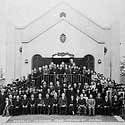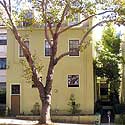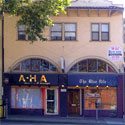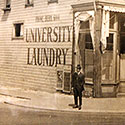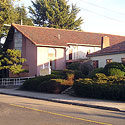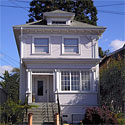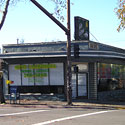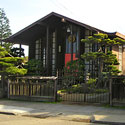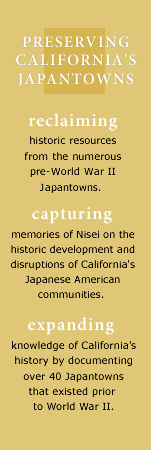 |
BerkeleyBerkeley's Japanese American community numbered over 1,300 at the start of WWII, with over 70 Nikkei-owned businesses scattered throughout the city. Japanese American residences were mostly restricted to Berkeley’s Southwest neighborhoods, where a mix of African Americans and recent European immigrants lived alongside other working-class families. In addition to many small businesses and cultural organizations, Berkeley’s Nihonmachi featured a variety of places associated with the University of California, including several student dormitories and rooming houses, and a Japanese Students Club that was active by 1910. The three East Bay communities in the Preserving California's Japantowns survey— Berkeley, Oakland and Alameda — have a remarkably high number of extant historic structures. More than half of the 100+ listings in Berkeley we surveyed are still in place, although many have been altered. ›› CLICK TO ENLARGE.
PROFILES
| ||||

One of several churches and temples serving Berkeley Nikkei prior to WWII, the Free Methodist Church was founded in 1916. It stood in this building on Derby Street from the 1931 until the congregation moved to El Cerrito in the late 1960s. A newer building constructed for an African American congregation has replaced this structure.

The Berkeley Methodist United Church (BMUC) was formed from three Christian church groups in 1929. Like many churches and temples, BMUC played a critical role during the internment and resettlement years, first as a location for storing members' belongings and later as a hostel for families returning to Berkeley. By the mid-1950s, BMUC had dedicated a new main chapel, and a large social hall next to its original 1930s structure. The first Chicken Teriyaki Food Fair Bazaar was held on October 13, 1957 An Issei Memorial Chapel and educational classroom were dedicated on October 14, 1962. To further beautify the surroundings of the chapel, a compact Japanese garden was donated by Mr. and Mrs. Tokuya Kako and designed and constructed by landscape architect Masaharu Imazumi.

Berkeley's Japanese American community had ties with the University of California. Gaining a college education was a considerable accomplishment for the children of American immigrants, such as the Nisei. Because Japanese American students faced considerable housing discrimination, they rented rooms in Nikkei boarding houses or in a dorm established by the Buddhist Church. This building on Euclid Avenue housed male Japanese students at UC Berkeley; the women’s residence hall just around the corner has been demolished and replaced by restaurants.

Offices for the Japanese Women’s Herald, a pre-war Nikkei publication, were listed at this South Berkeley house in 1941.

This Telegraph Avenue building held the studio of famed artist Chiura Obata in the late 1930s. Obata began teaching art at UC Berkeley in 1932, while exhibiting and lecturing across the United States. His wife, Haruko, was an esteemed teacher of ikebana (the art of flower arranging). They both had studios in this building, where their son Kim ran a store selling imported artworks from Japan. Daughter, Yuri Obata Kodani, remembers that the family found a bullet hole in the building's storefront window in the days following the attack on Pearl Harbor. During WWII, Chiura Obata organized art schools for fellow internees at Tanforan and Topaz Relocation Center. The Obatas returned to Berkeley after the war and Chiura resumed teaching at the University until he retired. Architectural historian Anny Su is working with Preserving California's Japantowns and Berkeley Architectural Heritage Association to prepare a local landmark nomination for the Obata studio.

University Laundry was founded in 1914 as a partnership of five small Japanese-owned laundries. Deciding they would benefit by cooperation rather than competition, the Fujiis, Kimbaras, Imamuras, Tsubamotos and Tokunagas opened shop in 1914. The families resided in living quarters upstairs that held a shared kitchen, dining and living room. This structure was built in 1895 and housed a French Laundry in its first two decades. It still stands at the corner of Shattuck and Blake Streets.

Berkeley's significant pre-war Japanese American community is visible if you look carefully. The Higashi Honganji Buddhist Temple, has served local Nikkei on their Oregon Street site for 80 years. Like many Buddhist Churches, the structure was dramatically renovated in the post-war period, yet the building to its right still looks as it did in the 1920s when it began serving as a center for Buddhist youth activities.

Berkeley has retained a surprisingly large number of buildings that held small Japanese owned businesses before WWII. This auto repair shop was once the San Pablo Florist run by the Nabeta family from the 1930s until 1995; at the time of our survey the property still featured remnants of an ornamental pond, greenhouses and an enormous pine tree that date back to its pre-war use. Unfortunately, the building was demolished in December 2007.
